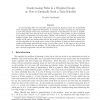26354 search results - page 145 / 5271 » How we refactor, and how we know it |
SODA
2008
ACM
13 years 11 months ago
2008
ACM
A travel booking office has timetables giving arrival and departure times for all scheduled trains, including their origins and destinations. A customer presents a starting city a...
APVIS
2006
13 years 11 months ago
2006
Visualizing social network data into sociograms plays an important role in communicating information about network characteristics. Previous studies have shown that human percepti...
USENIX
2004
13 years 11 months ago
2004
The X Window System is the de facto standard graphical environment for Linux and Unix hosts, and is usable on nearly any class of computer one could find today. Its success is par...
WOA
2001
13 years 11 months ago
2001
The Mobile Agent (MA) paradigm seems to be a promising solution for the design and development of distributed value-added services. However, mobility has added complexity to the d...
AHSWN
2010
13 years 10 months ago
2010
Considerations of realistic channel dynamics motivate the design of a new breed of opportunistic schemes, such as opportunistic transmission, scheduling and routing. Compared to t...

